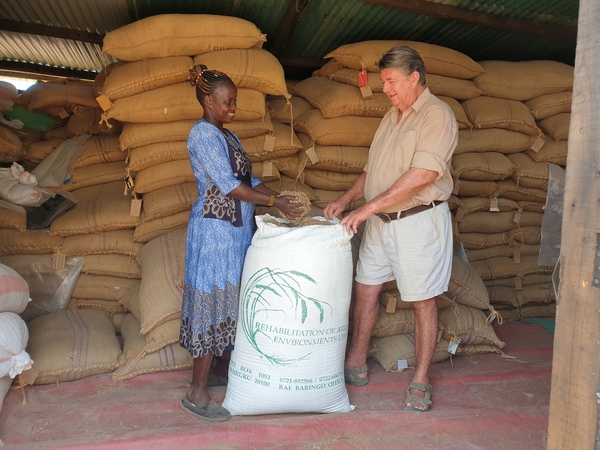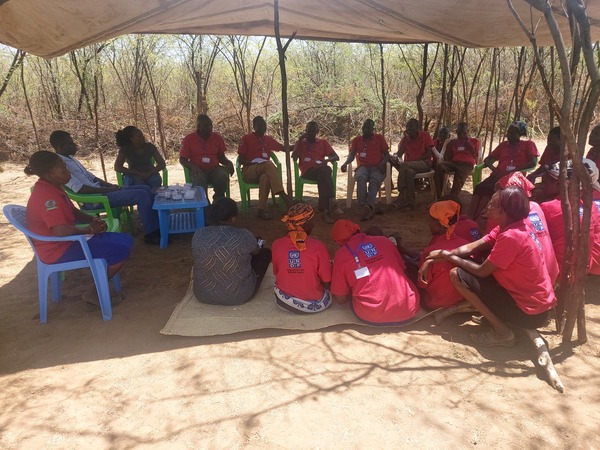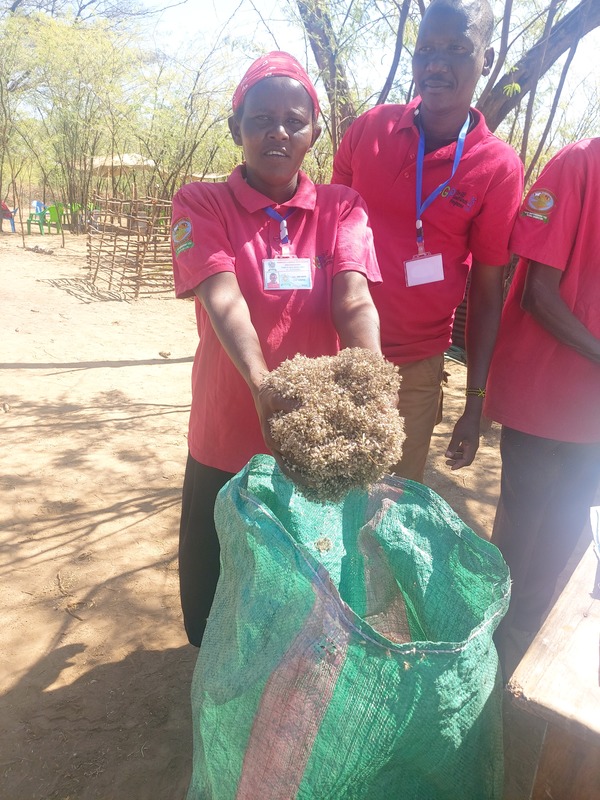Cattle grazing on a buffel grass field. Photo: Francis Parkorwa, Baringo farmer
** This publication is now available in non-colonial African languages: Swahili and Tugen **
Pastoralists are often ignored as custodians of Africa's biodiversity. Despite the various threats they experience – blocked migration routes, violence, and lack of schools and health care – the food systems they preside over remain the most resilient form of agriculture in the dry areas they inhabit. Unless their lands and the grass their animals feed on are privatised.
A worst-case scenario like this one threatens the Maasai and Kalenjin pastoralist communities in Kenya's Rift Valley province. The Maasai and Kalenjin are currently involved in a battle to stop an individual from obtaining monopoly rights over a variety of buffel grass that communities have used for their livestock since time immemorial. The situation exemplifies how plant breeders' rights (PBRs), a kind of patent on plants, can undermine African food producers and why the continent must fiercely resist the privatisation of biodiversity.
The importance of buffel grass to pastoralists in Kenya
Geoffrey Letakaan is a 63-year-old elder of the Kalenjin, an indigenous community of pastoralists that live in Baringo County, Kenya.
[1]
“The buffel grass has been there from the days of my father, grandparents to my great grandparents," says Letakaan. "This grass has a lot of value. If fed to cows, they fatten within three months. There is also hay for baling, and it is also used for thatching. In the past, the elders used to say 'nangrongong’, meaning ‘it (the buffel grass) is on the hills’ such as Arabal and Mukutani hills… People should plant this grass – everyone.”
His views echo many in Baringo county, a grassland area within Kenya’s Rift Valley province. The county is also host to the Ilchamus community, from the larger Maasai community. Both the Kalenjins and the Ilchamus are pastoralists who depend on their cattle and other livestock.
The pastoralists of Baringo are known for planting African foxtail grass (Cenchrus ciliaris), commonly called "buffel grass". Since time immemorial, community members have fed their livestock on it. The Ilchamus people also refer to this grass as “Lhogorr aingok” and the Tugens, a subtribe under the Kalenjin, call it “Lhomer Kwan”. They use this grass as a long term and permanent pasture because it is adapted to a range of soil textures, quickly responds to small rains and is recognised as the most drought tolerant grass.
In Baringo and other parts of Kenya’s arid and semi-arid lands, buffel is very important and versatile in its uses. Apart from using it as fodder, communities also bale it for sale and keep it for fodder for livestock during the dry seasons. With a high protein content of 12 percent, the grass is fast-fattening to livestock. Some community members have been known to do business by buying emaciated animals at low prices, fattening them with a diet of buffel grass, and selling them after three months at higher prices. Also, the seeds of this grass fetch a high price on the market, ranging from Ksh300 (US$3) to Ksh750 (US$7.50) per kilogram.
Women are responsible for feeding livestock among pastoralist communities, while men handle the grazing.
[2] Women, therefore, rely heavily on baling and storing buffel grass, especially for feeding young livestock during dry seasons, when pasture is scarce.
“I just go to the store, pick a bale and feed the kids (goats) and calves,” says 29-year-old Shalline Parkolwa. She notes that when the kids and calves are well fed, they need less suckling. More milk is then available for the family, thus impacting positively on nutrition and food sovereignty, especially among the children and elderly. Additionally, when men build huts, the women are given the task to look for thatching grass. Buffel grass straw is good for thatching as it is long and strong. Women can also earn income for personal and household needs by selling the seeds of buffel grass.
Enter Murray Roberts
Over the past few decades, a man named Murray Roberts, known to locals as "Omari"
[3] has led an effort to try and transform the local management of buffel grass – from a system based on communal land ownership and pastoralism to one based on private landholdings and intensive farming.

Robert Murray, director of RAE, and staff in the Baringo company store on February 17, 2021. Photo: Seed Savers Network (SSN)
Roberts is a Kenyan citizen who comes from a line of white settlers that acquired lands in the Baringo area during British colonial occupation and built up a lucrative family business of farms, conservation areas and safari tourism.[4] In 1982, Roberts founded a conservation organisation, the Rehabilitation of Arid Environments (RAE) Trust, to "transform degraded drylands into profitable rangelands for the benefit of the people and the environment".[5] RAE has been trying to do so by enlisting local community members into outgrower schemes for buffel grass production and lobbying local elders to provide it with plots of land to farm on.[6] In Roberts’ own words:
"We started here in 1982, first of all because of the donor, we were only allowed to deal with communities, so we have a lot of community fields around and then, when our donor changed, we could go into individuals. That is when we made a big difference. Because now we planted in the fields where the individual had a maize field, we started planting grass on that land. My partner is the one who came up with that idea. Now that whole idea of planting for private individuals has really taken off. This whole pasture thing has become an industry in Baringo. It is now an industry. And let me tell you, whether I am here or not, that industry will continue. It is not dependent on me now. The communal fields, if I am not here, they will die because there is nobody in the community who will look out into the community thing. They just want to eat them."
[7]
Locals say RAE's efforts have changed their relation to buffel grass. "Buffel grass has been here for decades. The only thing that community members did not know was its commercial potential,” says community member George Letakaan.
Today, many members of the local communities produce and sell buffel grass seeds. Some sell seeds through RAE, while others sell through the Kerio Valley Development Authority (KVDA), a regional government agency. One community member, Jackson Lekombe, who has chosen not to produce seeds for RAE, says he sells directly to KVDA and collectively through the Nooseya Self Help Group, whose 25 members engage in buffel grass baling and seed trade.
A seed grab
Roberts’ efforts to privatise the management of buffel grass seed did not stop at bypassing communities to work with individuals instead. In 2001, RAE began a programme of buffel seed production. In 2012, it applied for and was granted a certificate of protective direction – a kind of interim breeder's right while an application is pending – on a buffel grass variety by the Kenyan seed regulator, the Kenya Health Inspectorate Services (KEPHIS). The variety in question, which Roberts claims as his own, is called Baringo 1.
Upon grant of this certificate, Baringo 1 was added to Kenya’s National Variety list. This means that it cannot be commercialised without the owner’s permission. In 2014, Roberts went a step further and applied for plant breeders' rights (PBRs) on Baringo 1, aiming to take full ownership of the seed at the expense of farmers' rights. Roberts intends to register five more varieties for plant breeders' rights.
[8]Under Kenya's Seed and Plant Varieties Act of 2012 - which is based on the provisions of the Union for the Protection of New Plant Varieties Convention of 1991 (UPOV 1991)- any breeder, be they public or private, local or foreign, can apply for and get monopoly rights over a new plant variety that they have discovered or bred. This can, unfortunately, include farmers’ varieties. And this is where the conflict around RAE’s buffel grass arises.
For many local pastoralists, Roberts is trying to claim ownership over their biodiversity. Eresia Erige, a Baringo community member, says that as soon as the community became aware of Roberts' application for a breeders' right, local elders went up the hills and collected samples to compare with the varieties grown by RAE. They found that it was the same grass. For Erige, “The grass belongs to the hills and therefore, its seeds and farming in general should be for all and not be privatised.”
They are comforted in this view by the constitution of Kenya, which was revised in 2010 and says that local communities shall enjoy “ownership of indigenous seeds and plant varieties, their genetic and diverse characteristics and their use”.
[9] Based on the Constitution, Baringo communities should have community rights over buffel grass. However, the Seed and Plant Varieties Act of 2012 contradicts it and allows Roberts to obtain his own private rights over buffel grass. As a result, there is a conflict between breeders’ rights and farmers’ rights in Kenya.
The Kerio Valley Development Authority is also objecting Roberts' PBR application. In a letter to him dated 2016, KVDA stated that it had been experimenting and producing
Cenchrus ciliaris since 2001 and had entered the grass for national trials and tests. It argued that RAE Trust could not have bred the variety it submitted because it did not even have a plant breeding program. Furthermore, KVDA insisted that buffel grass should be owned by the public and that the Kenya Agriculture and Livestock Research Organisation (KALRO) should be its sole custodian in the public interest.
[10]
C
enchrus ciliaris, KALRO points out, is apomictic. This means that it reproduces asexually through seed.
[11] Anyone who claims to have developed a new variety of it would need to explain the breeding steps they undertook. To date, RAE has failed to provide this information. Critical to note is that this grass is also growing in other counties such as Kitui, Marsabit, Mandera, Kilifi and Makueni. In KALRO’s opinion, in a given population of
Cenchrus ciliaris, one would find
Baringo among the different ecotypes 99 percent of the time.

Nooseiya pastoralists/farmers from the Ilchamus community, February 11 2021. Photo: Seed Savers Network (SSN)
In 2016, KEPHIS organised a meeting with Roberts, the local communities, KVDA and KALRO to find an amicable resolution to the conflict. At the meeting, Kenya's public agencies, including the Ministry of Agriculture, Livestock and Fisheries, objected to Murray's PBR application saying the variety under consideration was "public" and had the benefit of being a naturally occurring variety and of "common knowledge". But Murray was unmoved. He repeatedly disrupted the meeting by standing up and accusing the community of taking "his seed". Murray claimed that he was the only one with breeders' rights on the buffel grass, and that the community, KVDA and other seed producers were violating the law.[12]
Table 1: Chronology of events
Period/Year | Event |
Until 1982 | Kalenjin and Maasai pastoralists graze their livestock on buffel grass across their rangelands |
1982 | Murray Roberts through his NGO, the Rehabilitation of Arid Environments (RAE) Trust, starts a buffel grass programme that involves local communities in Baringo |
1991 | The UPOV Convention is revised in Geneva to its current form |
1999 | Kenya becomes a member of UPOV |
2001 | Murray Roberts starts producing buffel grass seeds |
2010 | Kenya adopts a new constitution which recognises the rights of local communities to their seeds and associated traditional knowledge |
2012 | RAE Trust is granted protective direction on a buffel grass variety, issued by KEPHIS |
2012 (Dec.) | Kenya's Seed and Plant Varieties (amendment) Act of 2012 is adopted |
2014 | Tussle between Baringo communities, RAE Trust and KVDA over RAE’s plant breeders’ right application |
2016 | Kenya joins UPOV 1991 and becomes fully bound by the treaty |
2017 | Government gazettes the final certificate for RAE to market Baringo 1 buffel grass |
What’s at stake?
At stake in this conflict are Kenyan farmers' rights to freely save, share, exchange and sell buffel grass seeds. If the PBR is granted, they will not be able to produce or commercialise the seed without Roberts' permission and payment of a royalty. This will directly and negatively impact the livelihoods of the local communities that have always used and depended on it. In the case of Baringo 1, both the local communities and the public officials do not believe that Roberts' did the breeding work he claims he did. They formally contest the validity of his submissions to the national list and the plant breeder's rights authorities.
It is critical to note that RAE is not alone in seeking ownership of buffel grass. KALRO and KVDA are all institutions that have an interest in securing the monopoly of its commercialisation. The battle among them is fueled by the fact that RAE outwitted and outsmarted the other two in registering the variety. "KALRO also has the potential to exclude others. The problem is not any institution, but the seed laws based on UPOV 1991, whereby the community continues to suffer, the biodiversity continues to suffer, and farmers' rights are not protected," says Daniel Wanjama, Director of Seed Saver’s Network, Kenya.
The uncertainty for communities in Baringo thus remains high. Murray's PBR application is still pending approval and KVDA has launched legal action to stop it in an almost futile attempt.
[13] Meanwhile, Murray Roberts and the RAE Trust continue to multiply and sell the seeds. However, given the case's attention, he no longer threatens the communities about "planting his seed".
For now, the community members of Baringo are determined to continue growing buffel grass and are ignoring Murray's claims on their seeds. On this journey, they also have the backing of the Ministry of Agriculture, which has come out and said that breeders' right on Baringo 1 should not be granted.
[14] However, this is “a futile effort and nothing more than a PR exercise since farmers' rights were already being trampled when the Baringo variety was registered in the national variety list,” states Seed Savers Network’s Dominic Kimani.
No to RAE, no to KVDA, no to any ownership of seeds

Shalline Parkorwa, Nooseiya pastoralist/farmer from the Ilchamus community, showing buffel grass seeds on February 11, 2021 - Salabani village, Baringo. Photo: Seed Savers Network (SSN)
This whole conflict shows how laws and regulations that govern the seed sector are set up to benefit companies or individuals in direct contradiction with the rights of farmers and local communities. In the case of buffel grass, Murray is merely employing the door to seed privatisation set up by Kenya's Seed and Plant Varieties Act of 2012 - based on UPOV 1991.
It was just a matter of time before interests like RAE’s embraced the legal opportunity to claim monopoly control over a plant variety of common knowledge. True protection of pastoralists and farmers will only come when Kenya renounces to seeds laws based on UPOV. The current attempt of the KVDA and other public authorities to prevent Murray from obtaining the PBR must be seen for what it is: seed privatisation tug-of-war. Even if RAE’s PBR attempt fails, the pastoralists in Baringo still stand to lose their right to use, save and multiply Baringo grass, whether from KVDA or any other actor. Any attempt to protect Kenya's millennial and diverse plants should be made through its true custodians: the pastoralists, farmers and communities who have eked a living off of these plants for generations.
[1] The Kalenjin are an indigenous group that hails from Baringo County in Kenya's Rift valley province.
[3] Local community members, unable to pronounce his name correctly, refer to him as 'Omari'
[4] Elements of this family history are described on the site of a company run by Murray Roberts' relation: http://robertssafaris.com/our/history
[5] See: http://www.raetrust.org/
[6] See, "Part II Land Degradation and Mitigation in Africa," in
Land Degradation and Desertification: Assessment, Mitigation and Remediation," edited by Pandi Zdruli, Marcello Pagliai, Selim Kapur, Angel Faz Cano, Springer Science & Business Media, 2010, p.117.
[7] Interview by Seed Savers Network, March 2020
[8] Section 18 of the Kenyan Seed and plant varieties Act, 2012 set conditions for issuing plant breeders' rights/patents. Subsection 2 states (2) that an applicant for plant breeder's rights must be the person who bred or discovered the plant variety concerned or his successor in title, and the provisions of Part I of the Fourth Schedule shall have effect regarding priorities between two or more persons who have independently bred or discovered a plant variety.
[10] According to documents seen by the authors
[12] Interview by Seed Savers Network, march, 2020
[13] Interview by Seed Savers Network, March 2020.
[14] According to documents seen by the authors


